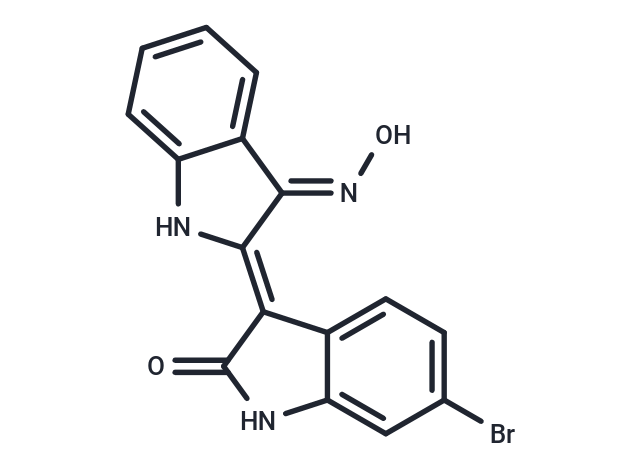Shopping Cart
- Remove All
 Your shopping cart is currently empty
Your shopping cart is currently empty

GSK 3 Inhibitor IX (6-BIO) is a selective reversible, ATP-competitive inhibitor of GSK-3α/β and CDK1-cyclinB complex. It inhibits (GSK-3α/β)/CDK1/CDK5 activity with IC50 values of 5 nM/320 nM/83 nM, respectively.

| Pack Size | Price | Availability | Quantity |
|---|---|---|---|
| 1 mg | $37 | In Stock | |
| 2 mg | $50 | In Stock | |
| 5 mg | $75 | In Stock | |
| 10 mg | $103 | In Stock | |
| 25 mg | $240 | In Stock | |
| 50 mg | $433 | In Stock | |
| 100 mg | $642 | In Stock | |
| 500 mg | $1,370 | In Stock | |
| 1 mL x 10 mM (in DMSO) | $83 | In Stock |
| Description | GSK 3 Inhibitor IX (6-BIO) is a selective reversible, ATP-competitive inhibitor of GSK-3α/β and CDK1-cyclinB complex. It inhibits (GSK-3α/β)/CDK1/CDK5 activity with IC50 values of 5 nM/320 nM/83 nM, respectively. |
| Targets&IC50 | CDK5-p35:0.08 μM, TYK2:30 nM, CDK2-CyclinA:0.30 μM, CDK1-CyclinB:0.32 μM, GSK-3:5 nM |
| In vitro | BIO inhibits the growth of melanoma in murine xenograft models. |
| In vivo | BIO is a pan-JAK inhibitor targeting TYK2, JAK1, JAK2, and JAK3 with IC50 values of 0.03, 1.5, 8.0, and 0.5 μM, respectively. It also acts as a specific inhibitor of glycogen synthase kinase-3 (GSK-3), with an IC50 of 5 nM for GSK-3α/β, demonstrating over 16-fold higher selectivity than for CDK5. BIO interacts with the ATP-binding pockets of these kinases, reducing phosphorylation at GSK-3 specific sites on β-catenin in cell models and promoting the proliferation of mammalian cardiomyocytes. Moreover, BIO selectively inhibits STAT3 phosphorylation, inducing apoptosis in human melanoma cells. In human and mouse embryonic stem cells, BIO preserves the undifferentiated phenotype and maintains the expression of pluripotency-specific transcription factors Oct-3/4, Rex-1, and Nanog. |
| Kinase Assay | Kinase assay: Kinase activities are assayed in Buffer A or C at 30°C, at a final ATP concentration of 15 μM. Blank values are subtracted and activities calculated as pmoles of phosphate incorporated during a 10 min incubation. Controls are performed with appropriate dilutions of dimethylsulfoxide. In a few cases phosphorylation of the substrate is assessed by autoradiography after SDS-PAGE. GSK-3α/β is purified from porcine brain by affinity chromatography on immobilized axin. It is assayed, following a 1/100 dilution in 1 mg BSA/ml 10 mM DTT, with 5 μl 40 μM GS-1 peptide, a specific GSK-3 substrate, (YRRAAVPPSPSLSRHSSPHQSpEDEEE), in buffer A, in the presence of 15 μM [γ-32P] ATP (3,000 Ci/mmol; 1 mCi/ml) in a final volume of 30 μl. After 30 min incubation at 30°C, 25 μl aliquots of supernatant are spotted onto 2.5 × 3 cm pieces of Whatman P81 phosphocellulose paper, and 20 seconds later, the filters are washed five times (for at least 5 min each time) in a solution of 10 ml phosphoric acid/liter of water. The wet filters are counted in the presence of 1 ml ACS scintillation fluid. |
| Cell Research | COS1, Hepa (wild-type, CEM/LM AhR deficient and ELB1 ARNT deficient), or SH-SY5Y cells are grown in 6 cm culture dishes in Dulbecco's Modified Medium (DMEM) containing 10% fetal bovine serum. For treatment, IO (5 μM), BIO (5 or 10 μM), MeBIO (5 or 50 μM), LiCl (20 or 40 mM), or mock solution (DMSO, 0.5% final concentration) is added to medium when cell density reaches ~70% confluence. After 12 (SH-SY5Y) or 24 hours, the cells, while still in plate, are lysed with lysis buffer (1% SDS, 1 mM sodium orthovanadate, 10 mM Tris [pH 7.4]). The lysate is passed several times through a 26 g needle, centrifuged at 10,000 × g for 5 min, and adjusted to equal protein concentration. About 8 μg of each sample is loaded for immunoblotting. Enhanced chemiluminescence is used for detection. The following primary antibodies are used: mouse anti-β-catenin CT (Upstate Biotechnolgies, Clone 7D8, recognizes total β-catenin), mouse anti-phospho-β-catenin (Upstate Biotechnologies, Clone 8E7, recognizes dephosphorylated β-catenin), mouse anti-GSK-3 β, mouse anti-GSK-3 phosphoTyr216, rabbit anti-AhR (Aryl hydrocarbon receptor), and rabbit anti-actin.(Only for Reference) |
| Alias | MLS 2052, GSK 3 IX, BIO, 6-bromoindirubin-3-oxime, 6-Bromoindirubin-3'-oxime, 6-BIO |
| Molecular Weight | 356.17 |
| Formula | C16H10BrN3O2 |
| Cas No. | 667463-62-9 |
| Smiles | O\N=C1\C(\Nc2ccccc\12)=C1\C(=O)Nc2cc(Br)ccc12 |
| Relative Density. | 1.8g/cm3 |
| Storage | Powder: -20°C for 3 years | In solvent: -80°C for 1 year | Shipping with blue ice. | ||||||||||||||||||||||||||||||||||||||||
| Solubility Information | DMSO: 45 mg/mL (126.34 mM), Sonication is recommended. Ethanol: 21 mg/mL (58.96 mM), Sonication is recommended. | ||||||||||||||||||||||||||||||||||||||||
Solution Preparation Table | |||||||||||||||||||||||||||||||||||||||||
Ethanol/DMSO
DMSO
| |||||||||||||||||||||||||||||||||||||||||

Copyright © 2015-2025 TargetMol Chemicals Inc. All Rights Reserved.